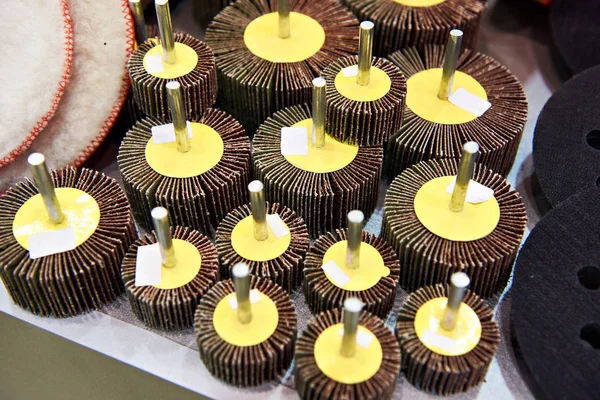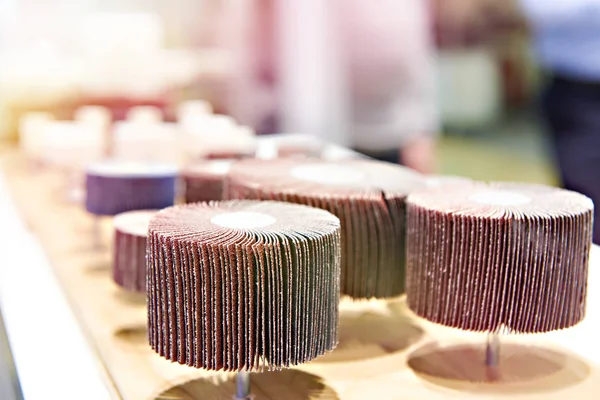Weld removal is an essential step in metal fabrication, crucial for achieving a smooth, polished finish on your workpiece. Among the various tools available, flap wheels stand out due to their versatility, efficiency, and ability to deliver a clean, even surface. This guide will walk you through the step-by-step process of using flap wheels for weld removal, exploring the advantages of different types like Flap Wheels with Shaft and Flap Wheels with Bore. We’ll also share tips to help you achieve the best results in your projects.
What Are Flap Wheels?
Flap wheels are abrasive tools designed for grinding, sanding, and finishing metal surfaces. They consist of multiple overlapping abrasive flaps arranged around a central hub. As the wheel rotates, these flaps grind against the workpiece, efficiently removing material and smoothing the surface. Flap wheels come in various types, including Flap Wheels with Shaft and Flap Wheels with Bore, each suited to different applications.
Flap Wheels with Shaft feature a metal spindle (shaft) attached to the wheel, allowing them to be used with hand-held drills or die grinders. This design is ideal for small-scale projects, intricate work, or areas that are difficult to reach with larger tools.
Flap Wheels with Bore have a central hole (bore) that fits onto a spindle or arbor of a bench grinder or other rotary tool. They are typically used for larger surfaces or when greater stability is required, making them perfect for more extensive weld removal tasks.
Why Use Flap Wheels for Weld Removal?
Flap wheels, whether with shaft or bore, offer several advantages over other grinding tools when it comes to weld removal:
- Flexibility:The flexible flaps conform to the contours of the workpiece, ensuring consistent material removal, even on uneven surfaces.
- Versatility: They can be used on various metals, including steel, stainless steel, and aluminum.
- Finish Quality:Flap wheels provide a smoother finish than grinding discs, reducing the need for additional finishing steps.
- Longevity:The overlapping flaps wear down gradually, continuously exposing fresh abrasive material, which extends the tool’s life.
- Efficiency: They remove material quickly and efficiently, making them ideal for both heavy-duty grinding and fine finishing work.
Step-by-Step Guide to Using Flap Wheels for Weld Removal
- Choosing the Right Flap Wheel
Selecting the appropriate flap wheel is crucial for effective weld removal. Consider the following factors:
- Material: Ensure the flap wheel is compatible with the workpiece material. For instance, a zirconia alumina flap wheel is suitable for stainless steel, while a ceramic flap wheel works well for harder metals.
- Grit Size:The grit size determines the flap wheel’s aggressiveness. Coarse grits (40-60) are ideal for heavy material removal, while finer grits (80-120) are better for finishing.
- Wheel Type: Choose between Flap Wheels with Shaft and Flap Wheels with Bore based on your tool setup and the scale of your project. For precision work or small areas, Flap Wheels with Shaft are preferable. For larger surfaces, Flap Wheels with Bore are more effective.
- Preparing the Workpiece
Proper preparation of the workpiece is essential for achieving a smooth finish:
- Clean the Surface:Remove any dirt, oil, or rust from the surface to ensure better contact between the flap wheel and the weld. A clean surface also enhances the efficiency of material removal.
- Secure the Workpiece: Use clamps or a vise to hold the workpiece firmly in place. This prevents movement during grinding, ensuring even material removal and protecting the workpiece from damage.
- Setting Up the Tool
Whether you’re using a hand-held drill, die grinder, or bench grinder, proper setup is critical:
- Mount the Flap Wheel:Ensure that the flap wheel is securely mounted on the tool. For Flap Wheels with Shaft, insert the shaft into the tool’s chuck and tighten it. For Flap Wheels with Bore, align the bore with the spindle and secure it with the appropriate fittings.
- Adjust Speed Settings: Depending on the tool, adjust the speed to match the task. Higher speeds are typically used for more aggressive material removal, while lower speeds are better for finishing and controlling heat buildup.
- Weld Removal Process
With your tool set up, you can begin the weld removal process:
- Start with a Coarse Grit:Begin with a coarse grit flap wheel to remove the bulk of the weld material. Hold the tool at a slight angle (15-30 degrees) to the workpiece and move it steadily along the weld seam. Avoid pressing too hard, as excessive force can wear out the flap wheel prematurely and damage the workpiece.
- Use Consistent Motion: Keep a consistent motion, moving the flap wheel back and forth across the weld. This ensures even material removal and prevents gouging or creating low spots on the surface.
- Check Progress Regularly: Stop periodically to check your progress. This allows you to make adjustments as needed and prevents over-grinding, which can weaken the workpiece.
- Switch to Finer Grits:Once the majority of the weld material has been removed, switch to a finer grit flap wheel to smooth out the surface. Continue with the same consistent motion, focusing on blending the weld area with the surrounding material.
- Finishing Touches
After removing the weld and smoothing the surface, complete the process with these final steps:
- Inspect the Surface:Check the workpiece for any remaining imperfections. If necessary, go over the area with a finer grit or polishing flap wheel for an ultra-smooth finish.
- Clean the Workpiece:Wipe down the surface to remove any abrasive residue or metal particles, especially if the workpiece will be painted or coated afterward.
- Apply Protective Coating:Depending on the application, consider applying a protective coating to the workpiece to prevent corrosion and enhance the finish.
Tips for Effective Weld Removal with Flap Wheels
To achieve the best results when using Flap Wheels with Shaft or Flap Wheels with Bore for weld removal, consider the following tips:
- Start with the Right Grit:Begin with the coarsest grit that is appropriate for the task. Starting too fine can make the process slow and inefficient, while starting too coarse can lead to excessive material removal and potential damage.
- Let the Tool Do the Work: Avoid applying excessive pressure. Flap wheels are designed to remove material efficiently with minimal force. Excess pressure can cause premature wear of the flaps and increase the risk of gouging the workpiece.
- Maintain Proper Angle and Motion:Keeping the tool at the correct angle and maintaining a steady motion are key to achieving a uniform finish. An inconsistent angle or erratic movement can result in an uneven surface.
- Monitor Heat Buildup: Excessive heat can affect the material properties of the workpiece, especially with metals like stainless steel. If the workpiece starts to heat up, take breaks or reduce the speed to avoid overheating.
- Use the Entire Surface of the Flap Wheel: As you work, try to use the entire surface of the flap wheel, not just one section. This helps the wheel wear evenly and extends its life.
- Keep the Work Area Clean:Metal particles and abrasive debris can accumulate on the workpiece, causing scratches or imperfections. Regularly clean the work area and the workpiece to maintain a smooth finish.
- Wear Protective Gear: Always wear appropriate personal protective equipment (PPE), including safety glasses, gloves, and a dust mask. Grinding can produce sparks, debris, and dust, all of which can be hazardous.
Common Mistakes to Avoid
Even experienced fabricators can make mistakes when using flap wheels for weld removal. Here are some common pitfalls to avoid:
- Using the Wrong Grit: Selecting the wrong grit size can lead to inefficient material removal or an overly rough finish. Always choose the grit based on the specific needs of the task.
- Over-Grinding:It’s easy to remove too much material, especially with a coarse grit wheel. Always check your progress and switch to a finer grit when necessary.
- Neglecting Tool Maintenance: A poorly maintained tool can lead to uneven grinding and reduced effectiveness. Regularly inspect and maintain your tools to ensure optimal performance.
- Ignoring Safety Precautions: Flap wheels can generate sparks and debris, which pose safety risks. Never skip wearing protective gear, and always be aware of your surroundings.
Conclusion
Whether you’re using Flap Wheels with Shaft for precision work or Flap Wheels with Bore for more extensive tasks, flap wheels are an excellent choice for weld removal. They offer a balance of efficiency, precision, and finish quality that is hard to match with other tools. By following the steps outlined in this guide and applying the tips provided, you can achieve professional results in your welding projects. Remember, success with flap wheels hinges on selecting the right tool, maintaining proper technique, and inspecting your work throughout the process. With practice and attention to detail, you’ll master the art of weld removal, producing clean, smooth surfaces every time.


